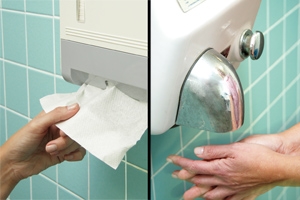The next time you are in a public restroom and you have the choice between using the forced hot air hand dryer and plain old paper towels, you may think twice before placing your hands under the hand dryer.
According to recent research done at the University of Westminster, in England, forced hot air hand dryers spread 1,300 times the germs, viruses and bacteria than standard paper towels. The study was recently published in the Journal of Applied Microbiology. The study found the incredible fact that an air dryer can actually blast bacteria and viruses as far as ten feet away from where a person is standing because the air is coming out at over 400 MPH.
The researchers used paper towels as well as jet dryers and hot air dryers and used the Dyson Airblade model hand dryer in particular for their experiments. Paper towels were found to spread germs and bacteria only ten inches away as opposed to the ten feet of the jet dryer.
A previous 2014 study done at the University of Leeds, in England, discovered that there were nearly 30 times the bacteria, germs, and viruses hovering in the air around a hand dryer as opposed to a paper towel dispenser.
One of the Leeds researchers, said, “The next time you dry your hands in a public toilet using an electric hand dryer, you may be spreading bacteria without knowing it. You may also be splattered with bugs from other people’s hands.”
The people participating in the experiment used latex gloves and immersed their hands in a harmless MS2 virus. They were then asked to use either paper towels or the hand dryers to dry their hands. After they were done, the scientists collected raw samples from where the hand drying had taken place using the different methods of drying.
In the end, the Dyson Airblade spread germs and bacteria 60 times more than a traditional air dryer and over 1,300 times more than regular paper towels. The Dyson Airblade has been trumpeted in many European countries as the hand dryer of choice.
PHOTO SOURCE: StateFoodSafety.com

